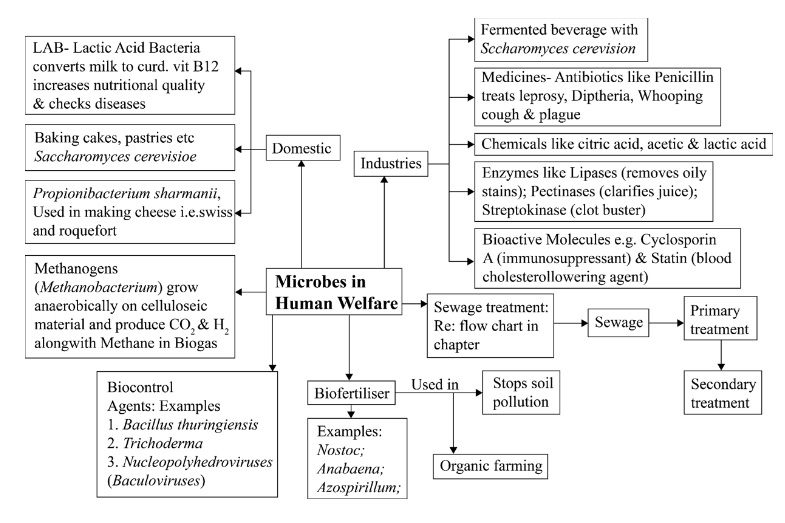NCERT Solutions for Class 12 Biology Chapter 8 - Microbes in Human Welfare
FAQs on NCERT Solutions for Class 12 Biology Chapter 8 Microbes In Human Welfare
1. What are the Topics Under Biology Class 12, Chapter 8?
The chapter covers various purposes for which microbes are efficiently employed. The main topics taught under the chapter include:
Microbes in household products.
Microbes in industrial production of chemicals, organic acids, enzymes, and other bioactive molecules.
Microbes in Sewage Treatment.
Microbes in Production of Biogas.
Microbes as Biocontrol agent.
Microbes as Biofertilizers.
2. How many Questions are There in the Exercises of this Chapter?
The chapter contains 15 questions in its exercises, divided into 9 short answer type questions (3 lines or less), and 6 long answer type questions (more than 3 lines).
3. What Role does Vedantu’s NCERT Solutions for this Chapter Play?
One of the major mistakes students make is not building a solid foundation of concepts. Mugging up theories cannot help you get a comprehensive knowledge of the subject. So learning the chapter by understanding the concepts and solutions is the best approach.
Vedantu’s NCERT Solutions is crafted and curated by a resident team of subject experts. They ensure that you get a complete theoretical understanding of the topic and also understand its implementation in daily life. The solutions are explained to relate to the theory taught in the best way, thus ensuring efficient learning and the best performance of students.
4. Name some traditional Indian foods made of wheat, rice, and Bengal gram (or their products) that involve the use of microbes.
Some traditional foods made of wheat, rice, an Bengal Gram are:
Nan made from wheat
Idli, dosa from rice
Pakoda , khandvi from Bengal gram.
To gain more insights into this chapter, students can make use of the NCERT solutions provided by the Vedantu to help them prepare for their exams. These questions and its solutions are created by the subject experts. Download the PDF from the Vedantu website or the app free of cost.
5. In which way have microbes played a major role in controlling diseases caused by harmful bacteria?
Antibiotics like Streptomycin, Tetracycline and Penicillin produced by microbes play an important role in fighting and killing the disease-causing microorganisms. Vedantu’s NCERT solutions provide detailed explanations for all the concepts in Biology Class 12. These solutions are prepared by the experts to clear the doubts of the students. To download the PDF of important questions free of cost, students are advised to visit the Vedantu website (vedantu.com).
6. What are the key features of NCERT Solutions for Class 12 Biology Chapter 8?
Vedantu provides NCERT Solutions for Class 12 Biology. The solutions are prepared by the experts in a very simple language for students to learn the concepts quickly. Students can also register for live online classes to get well versed in the subject. The NCERT solutions are crafted with no errors and provide authentic information. Students can download the NCERT solution free of cost at Vedantu platform.
7. Mention the topics included in Chapter 8 of NCERT Solutions for Class 12 Biology.
The topics in Chapter 8 of Class 12 Biology are:
Microbes in household products.
Microbes in industrial production of chemicals, organic acids, enzymes, and other bioactive molecules.
Microbes in Sewage Treatment.
Microbes in Production of Biogas.
Microbes as Biocontrol agents.
Microbes as Biofertilizers.
You can visit the Vedantu website to gain in-depth knowledge in Chapter 8 provided by the professionals.
8. What are human welfare microbes?
Microbes help the body kill the disease-causing microorganism by producing antibiotics. But few microorganisms are useful to our body. And they are Bacteria, Fungi, and Protozoa. These microbes help in human welfare. They help in digestion and protect the body from infections. The NCERT questions and their solutions help the students to secure a perfect score in the exams.
9. What is SCP in microbes in human welfare?
Single-cell protein refers to the protein produced by microorganisms like yeast, fungi, algae, and bacteria. These can be used as substitutes for protein, carbohydrates, minerals, and vitamin-rich foods and can be consumed by humans. Vedantu offers a PDF of the NCERT solutions for the students to help them in their exam preparations. Students are advised to download the important question on the official website of Vedantu or use the Vedantu app on their phones to access the PDFs.
10. Which sample would you carry and why?
One of the natural habitats for microbes is soil and water and it is easy to carry these samples. They can be observed under the microscope. Vedantu ‘s NCERT solutions are created by the experts with questions that enhance your understanding of the subject.
11. What is another name used to address the virus parasitizing bacteria?
Virus parasitizing bacteria is also known as Bacteriophages. Vedantu offers the best study material for this chapter. Visit the Vedantu website where the experts explain the concepts in detail and offer NCERT solutions to the students to ace their exam successfully. Since these solutions are prepared by the subject experts, students can also talk to subject experts to clarify their doubts.
























